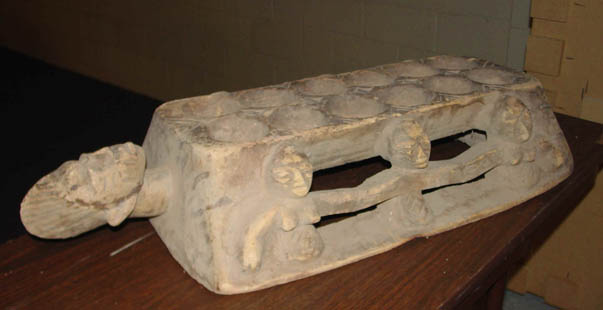 |
| Gameboard. Yoruba (Nigeria). Abeokuta area.
Wood. L. 22 in. Collection: Worcester African Cultural Center. Photograph: Jean M.
Borgatti. |
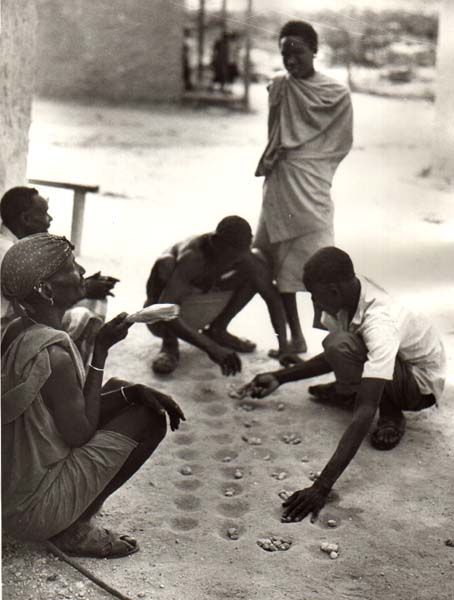
|
Photograph: Courtesy of www.driedger.com/mancala
|
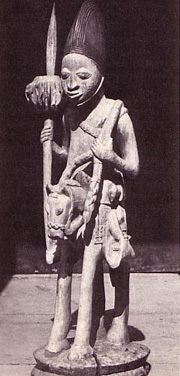
|
| Figure A. Shrine Figure (Ere Alafin Oyo)
Region of Old Oyo. Source: Willett, 2002, p.103 |
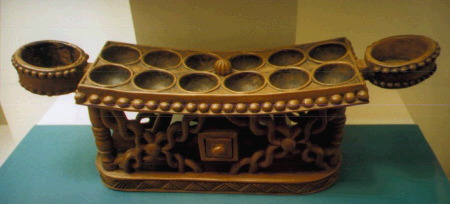 |
Figure B. Gameboard from
Sierra Leone. Source: Hardy,
1997 (Internet)
|
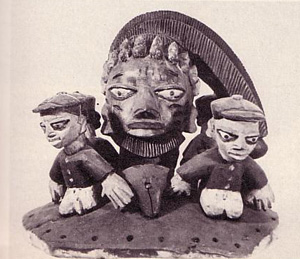 |
Figure C. Egungun headdress
carved by Adugbologe of Abeokuta. Source: Willett, 2002, p.161.
|
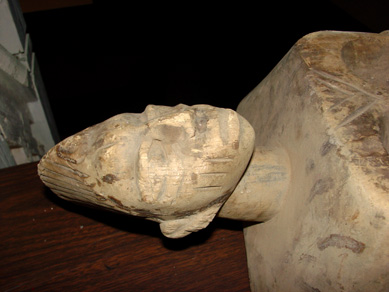
|
| Detail:Gameboard from Worcester African
Cultural Center Collection. Photograph: Jean M. Borgatti. |
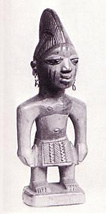
|
Figure D. Ibeji made
by Oniyide Adugbologe of Abeokuta. Source: Fagg & Pemberton, 1982, p.17.
|
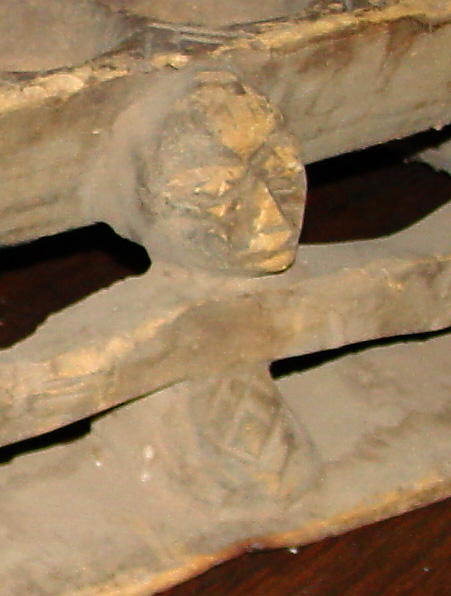
|
| Detail:Gameboard from Worcester African
Cultural Center Collection. Photograph: Jean M. Borgatti. |
 |
| Gameboard. Yoruba (Nigeria). Abeokuta area.
Wood. L. 22 in. Collection: Worcester African Cultural Center. Photograph: Jean M.
Borgatti. |
|

|
|
The artifact I chose to research is an African game board. It is a carved wooden, fairly rectangular object
with a total of twelve circular carved out pockets arranged in two rows, six pockets in
each row. The artifact is very light,
probably due to the drying out of the wood over time.
There are elaborate carvings that decorate the game board, along the sides and on
the top where the pockets are located.
The artifact is actually more
trapezoidal, than it is simply rectangular due to the fact that the top of it is larger
than the bottom and therefore the sides slants inwards.
The approximate dimensions of the game board are as follows: top – 20”x 12” / bottom –
22” x 12”. The shape of the game
board is further accentuated by the triangular shapes that are carved around the circular
pockets.
The artifact is much more than just a simple game board with carved holes for game
pieces; on the contrary the carved details add much more interest to the overall
appearance of the artifact. Along both of the
longer sides of game board are three people: two women and a man, the man is in the middle
of the two women holding each of their hands. The
holding of the hands seems to relay the message that this is a game that brings people
together. Their features are very detailed
especially those on the face. Each of the
figures appear to be wearing some type of patterned robe.
There is also a rather large head on the short side of the game board that is about
7” long. The head is facing upward
(towards the sky), and has a very distinguishable hairstyle and prominent facial features. On the figures and the head are scarification marks
on the cheeks and forehead. The
distinguishable hairstyle along with the scarification marks allow for the viewer to
identify this as artwork from the Yoruba people.
After speaking with the owner of the artifacts of the Worcester collection, I have also learned about who would have owned a game board like
this one and how it is played. These types of
game boards are usually found in the town square. They
are carved out of large tree trunks, along which many games that can take place at the
same time. The game is played with two people,
each person sitting on either of the longer sides of the board. Four seeds are placed in each of the carved wooden
pockets. The row of six pockets closest to
each player is considered theirs to try to keep filled with seeds. The players take turns by picking up all of the
seeds from one of the pockets and distributing one seed to each of the pockets in order. The first player to empty the other player’s
six pockets wins the game. It may be inferred
that the way this game is played, face-to-face, reflects the values of the culture
pertaining to interactions amongst people. Yoruba
people prefer interacting with others face-to-face, or directly, rather than sending
messages through other people. This value is
revealed in the playing of Ayo. I also learned
about who would own such an elaborate game board such as the one that I have chosen to
research. I discovered that due to the
elaborate carvings on the sides, it would usually be owned by a religious person of
stature.
The name mankala or mancala as it is sometimes written is derived from the Arabic
word naqala, meaning “to move something around.”
Mankala is actually a general name for the many variations of the game that are
played throughout Africa, as well as
many other parts of the world. The names of
the game boards are usually determined by what type of seed is used for playing, and game
boards may vary as far as the number of rows of pockets is concerned as well as slight
variations in the rules. Because the art piece
I am researching is from the Yoruba people, from now on I will refer to it as Ayo; but the
Yoruba people will also refer to it as Ayoayo, meaning “real ayo,” which
distinguishes the male version, from those played by women and children.
Ayo is usually played during the day, after work is finished. It is not just a game for the older crowd; in fact,
many young children learn how to play Ayo in order to sharpen their math skills. Ayo is generally played by people of the same age
group and gender, meaning men play with men, women play with other women, and children
play amongst themselves. The mixing of these
groups is very uncommon. As a tradition of
African society and the belief of male superiority, males and especially elders commonly
separate themselves from women and children in order to display their masculinity and
authority.
Some resources state that Ayo is not just a recreational game, but that it also has
spiritual significance:
“It is played in a house of mourning to amuse the
spirit of the dead before it is buried. It is
very unlucky to play the game at night as the spirits will want to join in and may carry
off the living at the end of the game. Each
village would have two types of boards, one with a flat top and one with a curved top, a
bit like a banana. When a man died the
villagers would play on the board that was not his favorite, so that his spirit would not
want to join in” (Mancala Games 2004).
It should be stated that these are traditional values that relate more
closely to the origin and cultural significance of Mankala; nowadays, this game board is
played worldwide and many of the original values are not upheld or recognized.
The figural supports created on either side of the game board may also represent
certain cultural values of the Yoruba people. As
stated previously, there is a male figure between two female figures on each side of the
board. Relationships are said to be an
important part of their culture, and the relationship between men and women may be
reflected in this piece of art. “For the
Yoruba, life is an aggregate of relationships – relationships with other persons,
with nature, with disease and death, and with one’s own past, as well as one’s
personal destiny. Relationships are never
static” (Fagg and Pemberton p.164).
Traditionally,
Ayo game boards are made of wood and are carved with intricate designs. The sound of the seeds, or whatever medium one uses
for game pieces, dropping into the depressions is said to rhythmic, and the wood becomes
smooth and conditioned from the constant motion of the game pieces. Game boards can also be made out of clay, rock, or
even simply by carving circular depressions into the ground (seen in the photograph to the
right), while game pieces can range anywhere from seeds to nuts to cowrie shells, even
pebbles are acceptable, but it is important that the pieces are fairly uniform in size and
shape.
It is important
to compare this particular Yoruba piece with other artwork from the same region in Africa in order affirm its origin as well as
analyze specific perspectives in relation to features that distinguish this piece from
other Yoruba works of art. It has previously
been noted that the majority of mankala game boards created throughout Africa are not
elaborately carved, and the fact that this Ayo does contain carvings of people on both of
the longer side of the board as well as a head at one of the shorter sides means that this
board was created for someone of high political or social status. The facial features of the people on the game board
are also of importance. The faces show
scarifications on the cheeks and forehead that allow the viewer to associate this Ayo
board with an artist from the Yoruba region of Africa in Nigeria. The rather
different hairstyle, or coiffure resembles a crest running from the front of the forehead
to the back of the neck, along with the bulging eyes, elongated nose, broad nostrils and
large lips also provide important information in relating this piece to the Yoruba
peoples. The large, protruding almond-shaped
eyes are also a very important characteristic of Yoruba carvings. These features can also be seen on the Yoruba
wooden form represented in Figure A.
In comparison with other mankala boards found throughout Africa, the Ayo game board analyzed in this paper is not all that detailed. The wood is worn and has not been treated with any
type of dye, unlike many others which are very dark and polished. It appears as though it may have had some type of
darker finish, due to the small remnants that remain of the darker wood, but overall it
looks as the finish has been removed. The game
board to the left (Figure B) is elaborately carved and the fact
that it is made with two rows of six pockets denotes that it is from northern or western
Africa, and this particular board is from Sierra Leone, which is west of Yoruba. The simplicity of the Ayo game board in comparison
with other mankala boards from the same region could mean a number of different things. It is possible that it was a piece created for
someone that was not of exceptionally high social status, but it is also possible that it
is an older piece and some detailed that may have been present when the piece was first
created have been worn off. It is important to
note that the piece cannot date before the 19th maybe even 20th
century, since wood can deteriorate very quickly, especially in Africa where termites are very prominent. Although
the figures on the Ayo game board are not painted, they are very
similar to a more recent sculptural piece from the egungun cult of the Yoruba (Figure C). This particular piece depicted in Figure C is from
the Abeokuta region. The facial features are very similar and the
stature and positioning of the body as well as the technique used to carve the hands are
very much alike. The reaching out of the arms
as well as the proportionality of the features share a striking resemblance to the game
board under speculation.
Although it is not as visible in the pictures taken of
the Ayo game board, the figures appear to be wearing woven skirts depicted by cross
hatchings in the wood. This technique and
style of clothing is also represented in an art piece of an ibeji figure from Abeokuta. The three scarifications on the forehead
and both cheeks, along with the coiffure and the wide nose also support the idea that the
game board may also be from the same area (Abeokuta). It is also important to note
that it is traditional for art from the Abeokuta region to be marked with a “logo” of sorts, which is viewed much
like a signature in Western art. This
trade-marking is traditional only to this region of Yoruba.
Triangles are carved along the sides of the game board as well as at the top and
bottom, possibly signs that this it is also a piece from the Abeokuta part of the Yoruba region.
The Ayo game board of the Yoruba people although it appears to be a traditional
piece, I believe that it was created in the early to mid 20th century. The piece is not exceptionally detailed and it
does not appear as though the artist was highly skilled, especially in comparison with
other Mankala boards from the same region. Other
game boards have some type of finish applied that give the wood a darker, more polished
appearance whereas the wood on this board is rather light; it appears as though it may
have once had a some type of finish, but most traces of the finish have been removed. I have concluded that this Ayo board is from the Abeokuta region of Yoruba land, due to facial
characteristics and the appearance of the coiffure it shares with many other art pieces
from this area. Cultural connections and
inferences can be made about the game of mankala, concerning interactions among people in Africa (e.g.: their preference to interact with
others face-to-face, which is how the game is played).
One can also infer about the meanings of the designs that appear on the
sides of the game board and their cultural meanings, although we cannot be sure of the
meanings due to the lack of collection data associated with many African works of art. |






